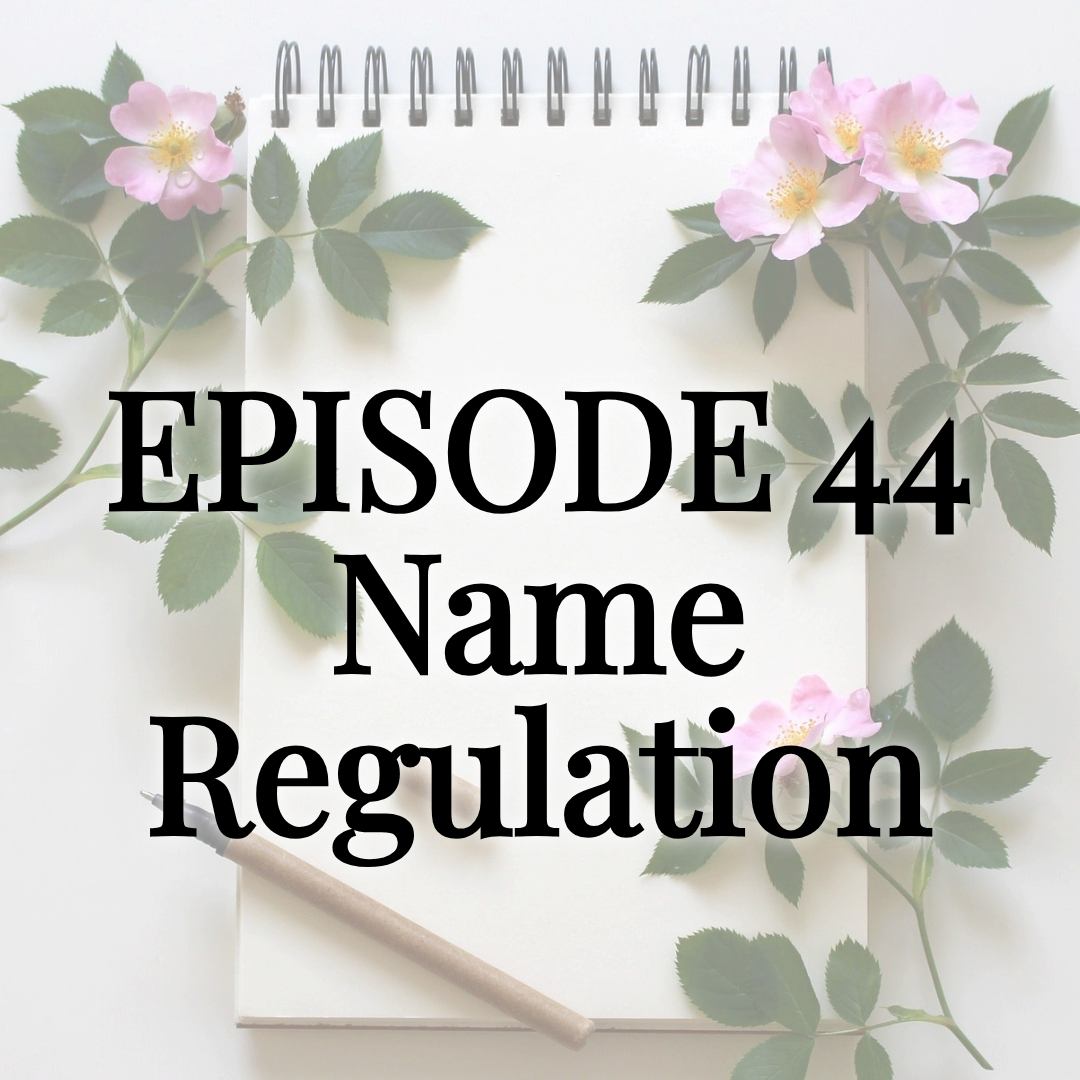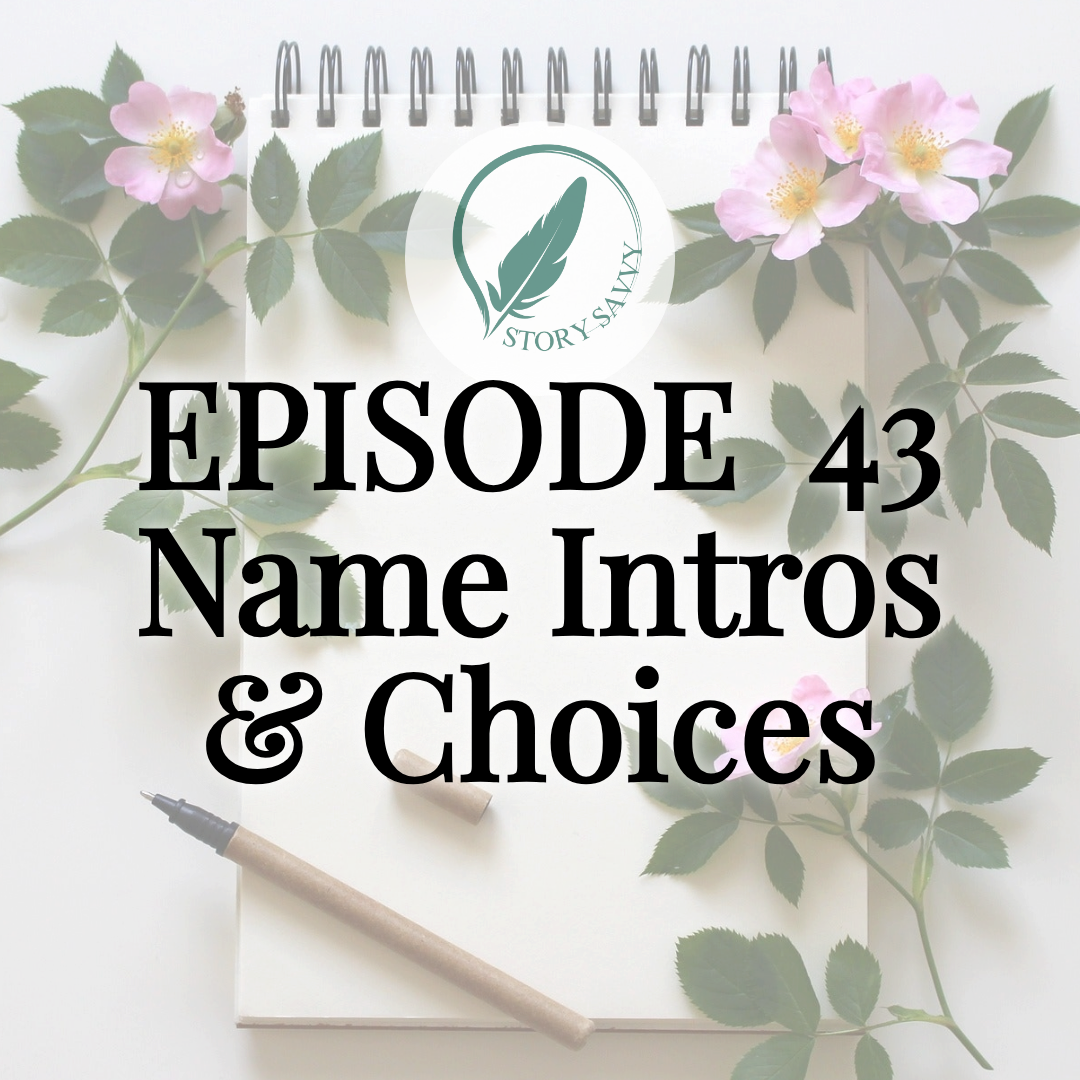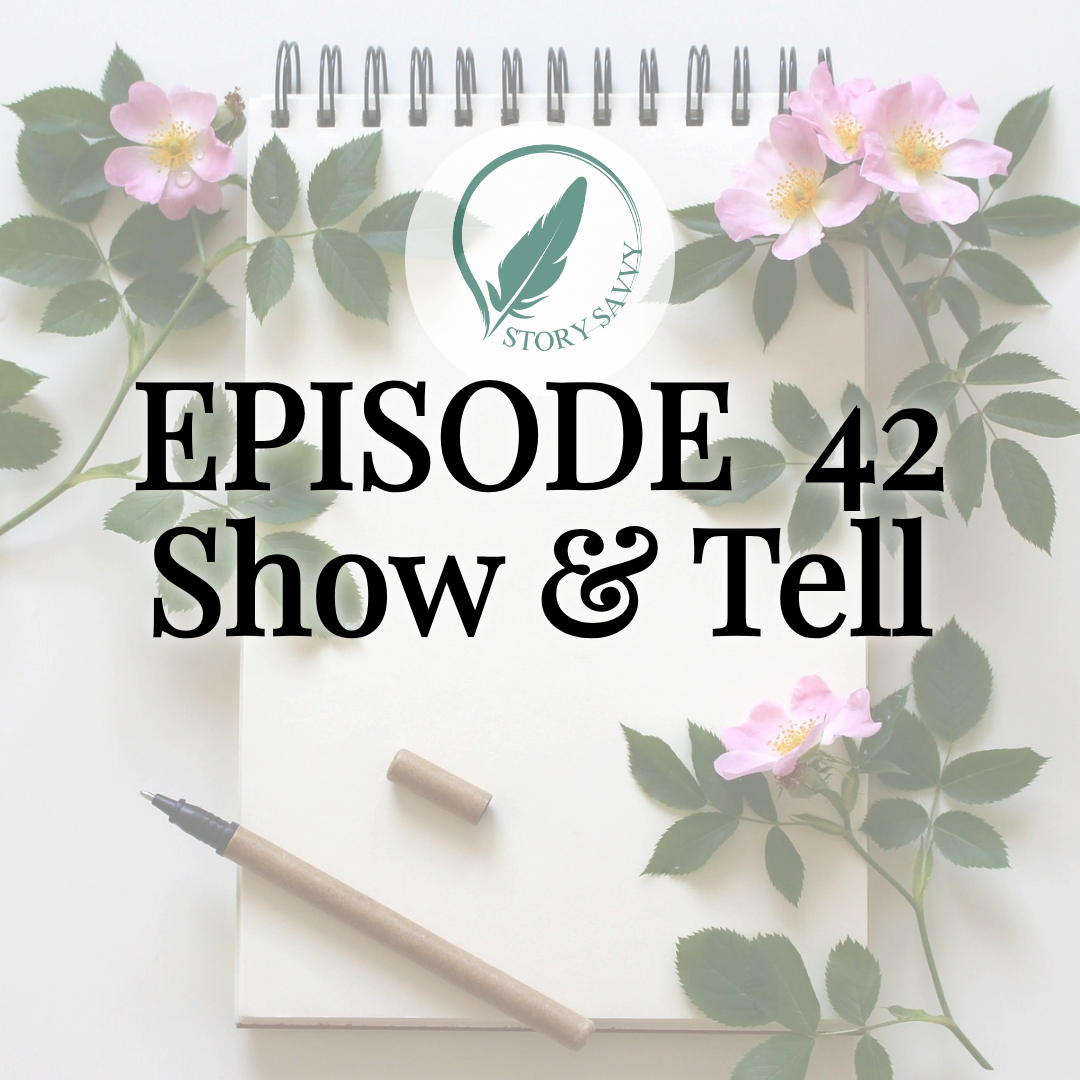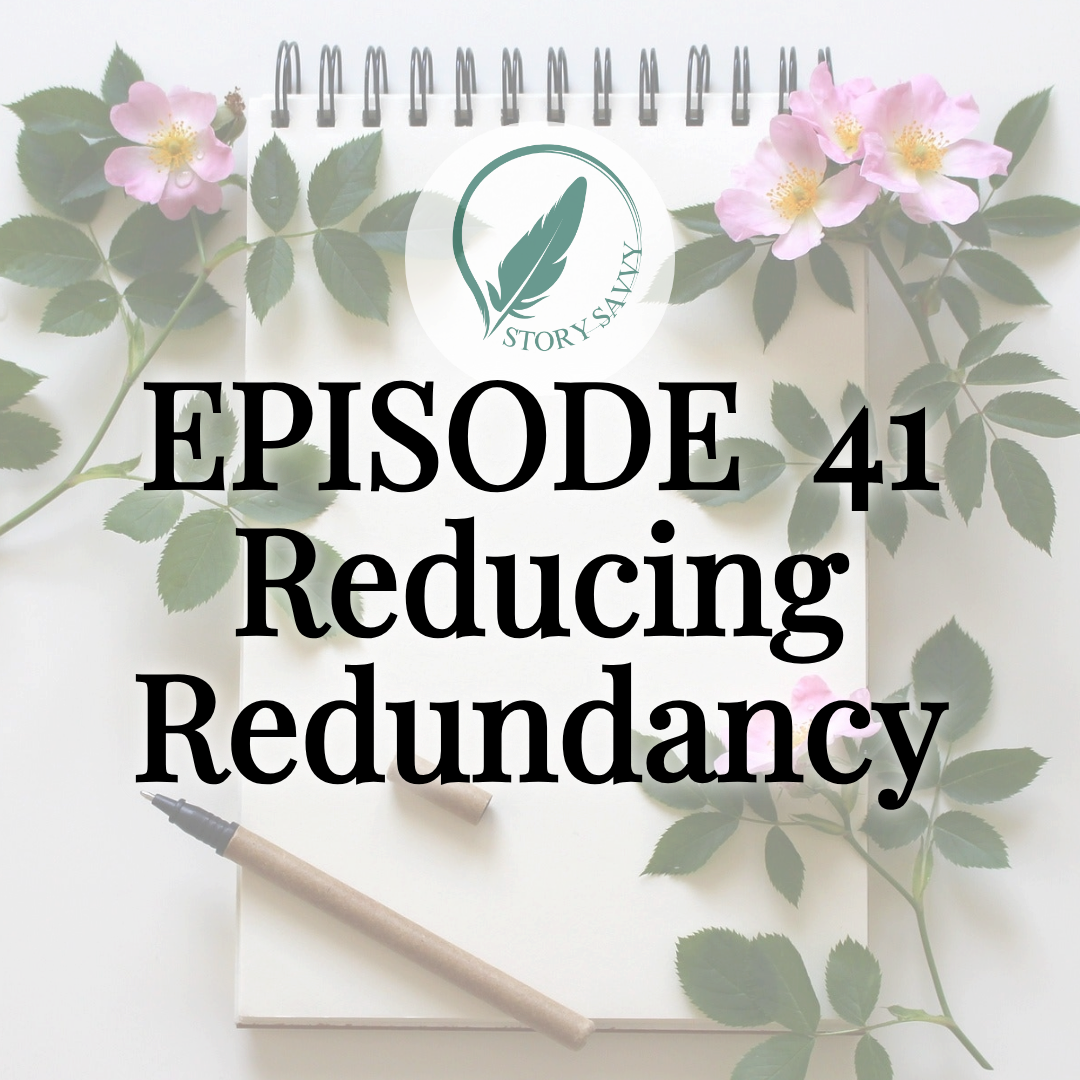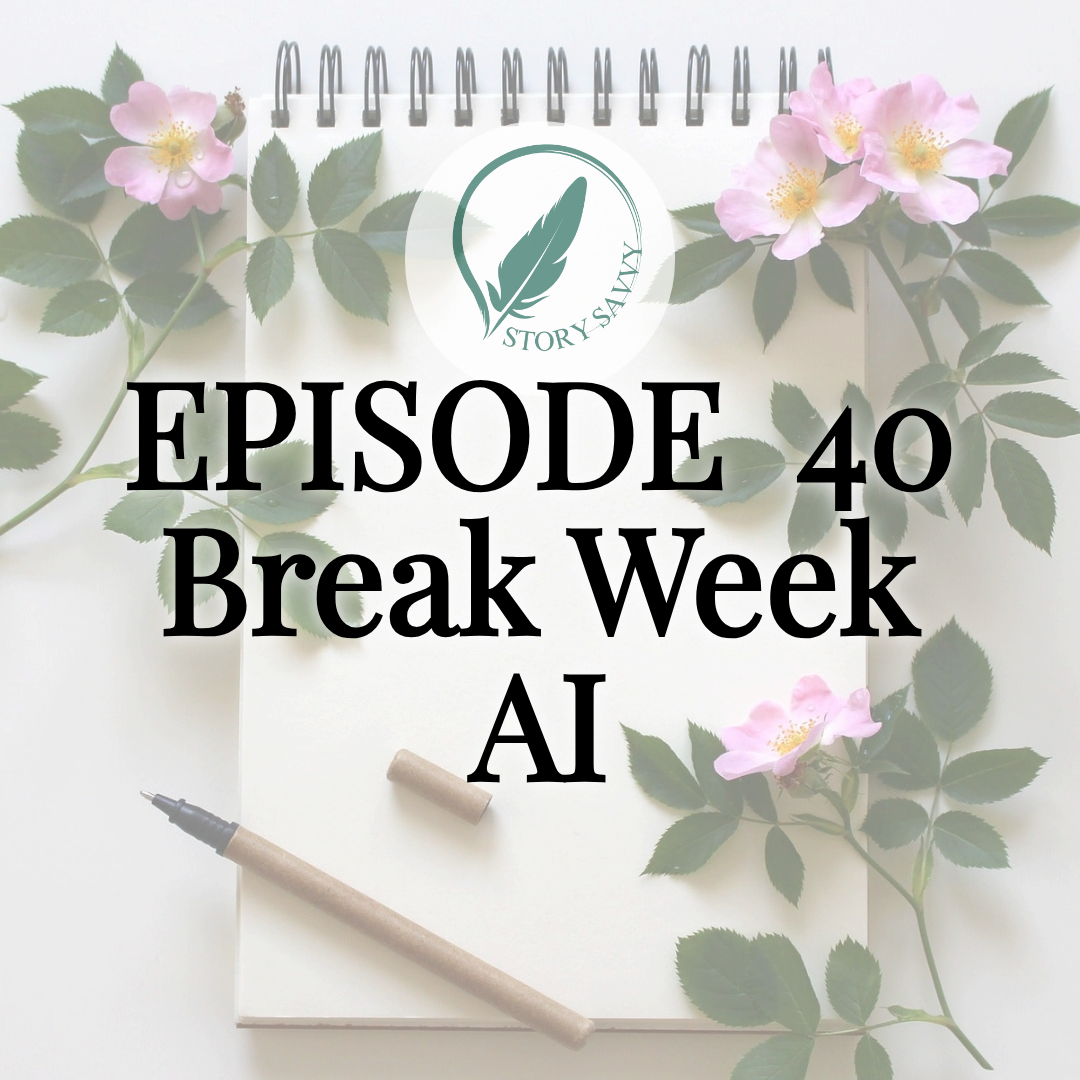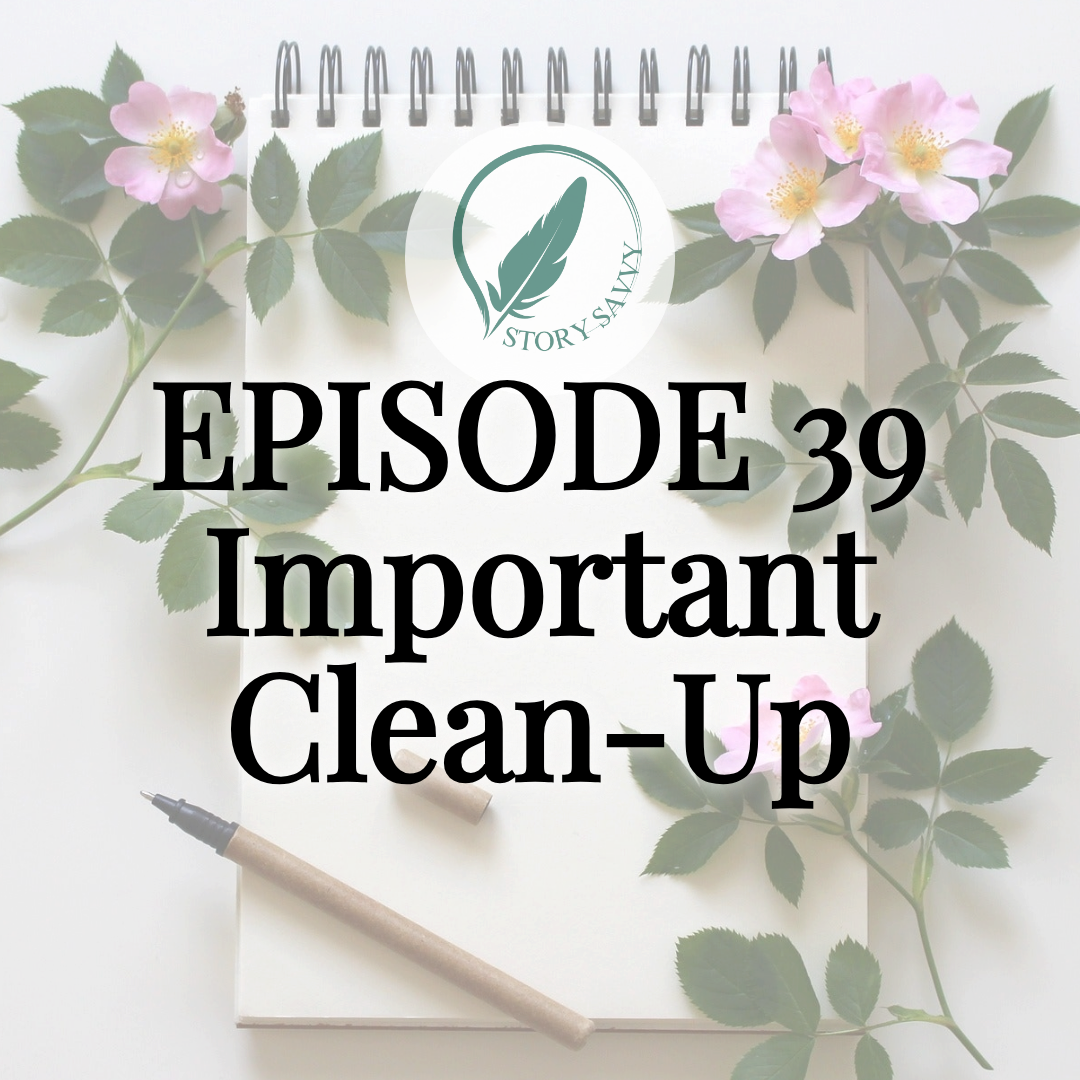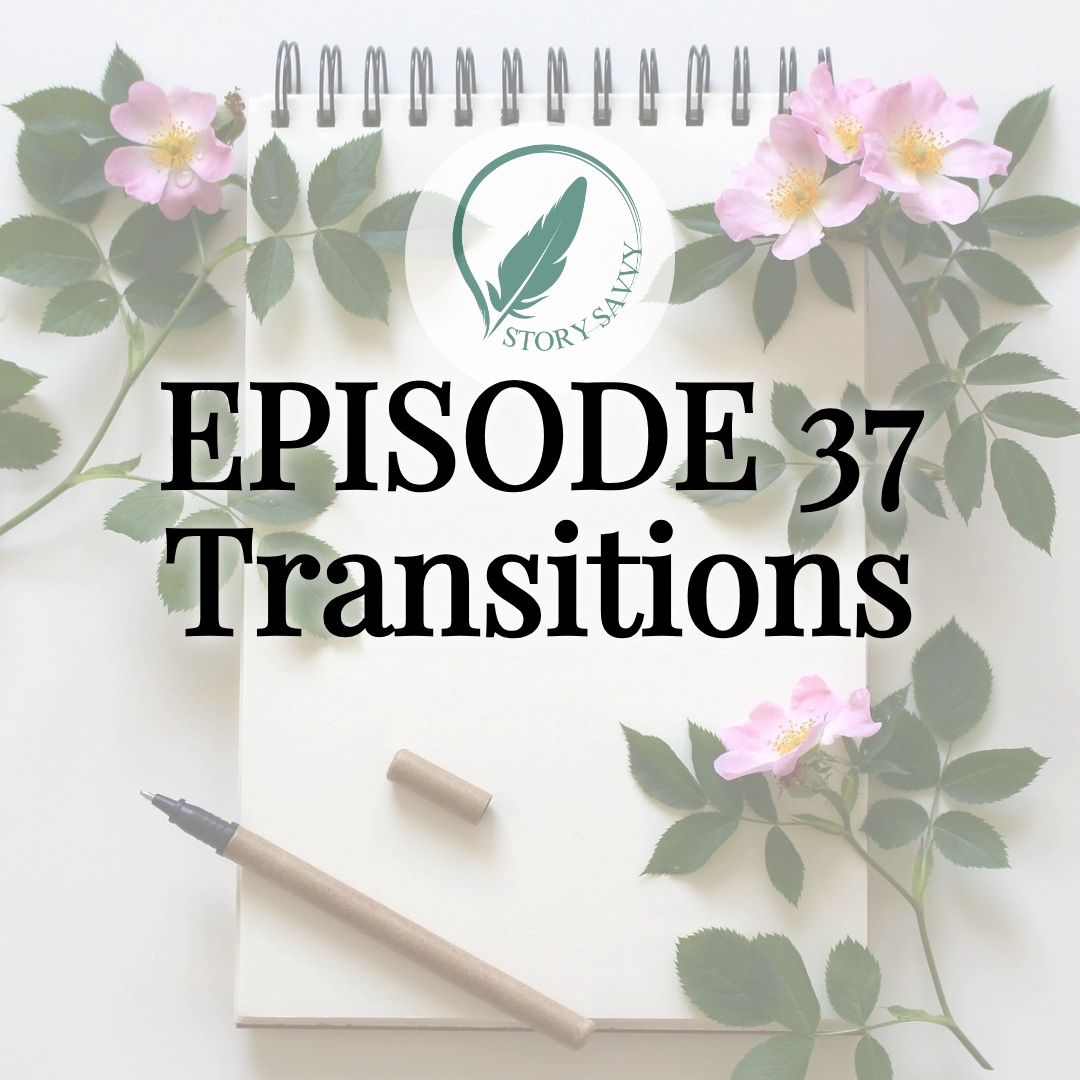Plot Holes & Character Inconsistencies: Story Savvy Self-Editing Episode 19
My sincere thanks to Sue Mills for guest-hosting!
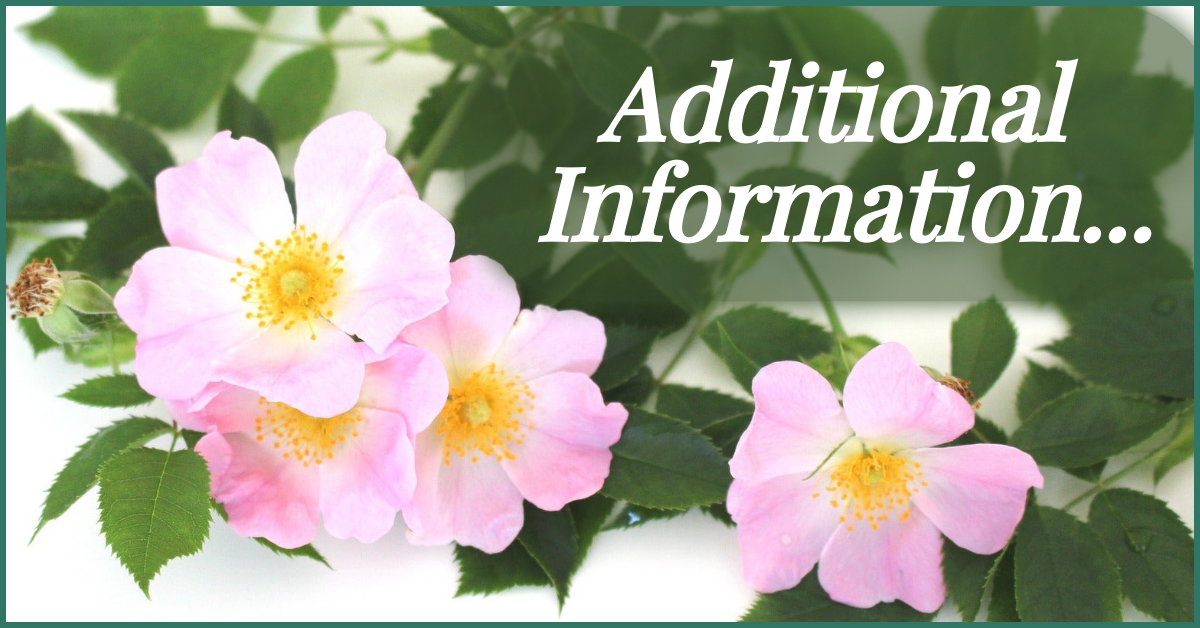
You can find the links to Sue's books in the show notes below! I really appreciate her stepping in on short notice to cover for my usual co-host, Agnes Wolfe.
Episode 19 Overview:
Plot Holes & Character Inconsistencies
"What are plot holes and character inconsistencies? How can I best catch and fix them?”
In this week’s episode, Rebecca Hartwell, a developmental editor, discusses how to spot plot holes and character inconsistencies. Writing strong plots and fixing story problems are a big part of self-editing fantasy novels, which is just a little of what we cover in episode 19 of 52-Week Story Savvy.
In this episode, editor Rebecca Hartwell shares practical techniques for identifying and repairing plot holes, ensuring your story’s logic holds up from beginning to end. Guest host Sue Mills [suemillsauthor.com], author of contemporary romance of Whispers of New England, joins Rebecca to explore how small inconsistencies can undermine reader trust—and how to fix them without unraveling your whole plot.
They also dive into strategies for:
~Spotting contradictions and missing information
~Brainstorming solutions without creating new problems
~Addressing character inconsistencies in backstory, skills, and personality
~Seeding believable character growth throughout the narrative
~Evaluating feedback to distinguish true plot holes from intentional ambiguity
Whether you’re revising your first draft or troubleshooting a polished manuscript, this episode will help you strengthen your plot’s foundation and keep your characters consistent and compelling.
In This Episode:
~How to spot and fix plot holes
~Tools for reading your draft with fresh eyes
~Managing character inconsistencies
~Balancing believable growth and complexity
~Avoiding accidental contradictions
~Turning feedback into actionable revisions
Recommended Resources:
Hart Bound Editing Services – [https://hartboundediting.com]
Sue Mill’s Books – [https://www.suemillsauthor.com/]
Authors’ Alcove Membership Community – [http://authorsalcove.com]
Sue Mills on social media – [https://www.facebook.com/suemillsauthor]
Book Giveaway – [http://authorsalcove.org]
See you next week for episode 20: Deus Ex Machina!
Episode 19 Transcript:
Plot Holes & Character Inconsistencies
Rebecca Hartwell: Hello and welcome to the Hart Boud Editing Podcast. This is episode 19 of the weekly Story Savvy series where we tackle the 52 biggest self-editing topics and tips to help you make your good story great, as a published author asks me, a developmental editor, all of the questions that you have wanted to. My usual co-host Agnes and I have covered a bunch in this series so far and last week my guest host Lyndsey and I went over self-editing for appropriate intensity.
Today, my temporary new co-host Sue and I are going to take a look at planning plot holes and character inconsistencies. By the end of this episode, you'll hopefully feel confident identifying where you have plot holes. You can hopefully know how to approach plugging them and have a better understanding of how to play with character consistency and inconsistency skillfully.
Joining me to ask all of the questions is my friend and former client Sue Mills, the author of four books, all in the Whispers of New England series. Why don't you tell us a little bit more about you and your work before we dive in with our first question?
Sue Mills: Hi. I am excited to cover this topic with you. I think it's what many newer authors think is the entirety of macro self-editing. A little bit about me; I have been writing since 2020. I am a lifelong reader and didn't think I'd ever be a writer.
Rebecca edited my first manuscript. She was the first person to read it. A very, very, very rough draft. She gave me insight and tidbits that I still hear in my mind today as I'm writing. So, I am very appreciative to her.
I write steamy, cozy love stories. I don't necessarily call them romances because I don't always hit all those beats. They feature men with a little bit of vulnerability and the strong women they fall in love with. And they also have a very strong family and friendship component. I have a free prequel that's available on my website and I have published four books. My fifth one is coming out on May 15th. Yeah, I'm rapid releasing.
I release every 60 days. They're about—250 pages is the length of my books. Generally, the last one is actually longer than that and so I am very busy with writing and editing all the time.
Rebecca: Sounds like it. And I don't know if you know this, but your book that I read and gave feedback for was I think like the second book that I ever edited like that. So, it still lives in my head to a pretty good degree too because I was so new to that and your stories are very sticky.
Sue: So, to get started, what exactly is a plot hole and how can we identify them?
Rebecca: So, plot holes can show up in a couple of different ways. The most obvious one, in my opinion is just inconsistencies. So, you establish something in chapter five and then in chapter seven that's different. It's not consistent with what had been established previously.
Another way that this can show up is contradictions. So not necessarily just it being different, but you say two things that directly contradict each other. Kind of two ways to look at the same thing, but I still wanted to say that.
Another way to look at plot holes is assuming the reader knows something that you never told them. So, if 2/3 into the book you mention, “oh, this character as the king did so and so,” but you never told anyone who the king was or anything like that, where you are relying on the reader having information that you forgot to actually give them is a plot hole.
Another way to look at it is: a plot hole is a break in logic which you haven't established as part of your world building. And I know you write contemporary romance, so logic is pretty simple for you. For folks in the fantasy space that can get a little bit more complicated because magic can break a lot of logic rules, but you need to do those in an intentional way. And when it's not established intentionally, that can come across as a plot hole.
As for how to spot them as you're doing your self-editing, there are a couple of things that I recommend.
First and foremost is trying to read like a reader rather than like the author who wrote it, which I know can be very difficult, or reading like an editor. When you're reading like a reader, it's more likely that you're going to catch plot holes rather than catching typos or grammar mistakes or thinking, “oh man, I edited for my message way back in this process. I'm not sure it's coming through.” Trying to read as a reader can really help catching the plot holes.
You can also try consuming it differently from how you normally would. Such as consuming it with your ears through a text-to-speech software rather than with your eyes. Or you can change your formatting, so, your font and your spacing and all that kind of stuff. And you can try putting it on a different device. So, if you have done all of your reads so far on your laptop, try downloading it on your phone or your Kindle, or print it out and read it physically. Getting that consumption of your story coming through a different part of your brain, even if it's just a little bit different, can really, really help in consuming it with fresh eyes.
Lastly, outside feedback is really vital to plot holes because—especially for the kind of plot holes where you're assuming the reader knows more than they do or was told more than they were—it can be almost impossible to see that from the inside. So, getting outside feedback is very, very important.
Sue: Okay, thank you. What if the plot hole seems so big that it will change your entire story? What do we do then?
Rebecca: This can be very daunting. I have faced this in my own books, so my first and foremost recommendation, which I know I've said before and will probably say again, is: set things aside and let it ruminate. Let your subconscious mull over it for a while.
When you've done that, if that's even needed, then brainstorm a series of alternate solutions. So, if the first solution that came to mind is going to break the story, then just brainstorm if there are other ways that you could plug the hole—other fixes that might have much smaller impact and allow the story to stay more how it is.
You can also consider scrapping or replacing the element that's introducing that big of a plot hole. That's what I ended up doing in the first book that I wrote is I had a magical tool that was breaking the world and I couldn't come up with a way to plug that plot hole that wouldn't destroy the story. So, I ended up taking that element out entirely and replacing it with something similar that wasn't as big of an issue.
Lastly, you can decide just which side of the problem is worth it. If you've gone through these other options and you're still looking at either having a massive plot hole or completely changing the story, you just need to really sit with yourself and decide if it's worth changing that plot hole—or, sorry, fixing that plot hole—but changing the story or not doing that. You're going to have to pick between one of these two evils and put in the work to do what you can with one side or the other.
Sue: Right. I have used at least two of those solutions. I do a lot of “what if? What if this, what if that?” and then the other thing. I have tried to hammer pieces into stories and finally said, “you know what? This has got to go. I can't make it fit.” So that's really helpful.
What if, when we have others read our work, they see a plot hole, but we are purposefully setting up ambiguity for items later in our series? Would this be more how we are executing the plot?
Rebecca: So, yes, it has something to do with, you know, setting up expectations and that is part of the plot. So, I think that this would count as executing the plot. A few options for approaching this outside feedback, and feeling like they're misinterpreting it, include:
Ignoring that feedback. That is always a valid option. It should never be your default option, because then what's the point of getting outside feedback? But if you read a piece of feedback about, “hey, this plot hole is bugging me,” and you sit with it and you're like, “no, I'm right, they're wrong, they missed something,” then you can make the choice to ignore that. However, I suggest that at a minimum, you try reading whatever section they flagged as having a plot hole with fresh eyes as much as you can, and make sure that your wording and the way, the exact way, that you're presenting it is coming across how you'd intended and in a way that will be clear to your readers if they aren't inside your head.
Also consider not using mystery and intrigue in the form of withholding information as momentum. I often give feedback about this to my clients. When you're doing that, which is often where you will get outside feedback “of this is a plot hole,” but you know that it's not, it's because you're trying to introduce this question of, “wait, I don't understand. I'm going to keep reading so that I can understand.” And that's not actually the most effective means of momentum. If you instead choose to provide these details that are being withheld—that is creating this sense of a plot hole—when you provide those details, you can instead use anxiety, excitement, or anticipation as that forward momentum, which can often be a lot healthier for the story.
Sue: I have read books where I've been so confused and I keep reading because, “okay, well, eventually they're going to tell me what's going on.” But that can be very aggravating.
Do you feel that all plot holes need to be fixed?
Rebecca: I suggest fixing as many as you can, and especially any that an outside reader spots. To be clear, even huge books and—and I can think of Harry Potter right off the top of my head—have tons of plot holes, but they are usually buried deep enough that most readers don't notice. Only the superfans who reread and re read and reread and kind of get obsessed are going to spot them. So, if you can get your book to at least that level as far as plot holes and character inconsistencies go, where someone who reads it once casually is not going to spot them, that's okay. So, my advice is fix everything that you notice, but don't stress yourself silly trying to catch everything. And if you spot a plot hole after publication, yeah, maybe make a note of it so you can change it if you ever do a re-release. But don't over stress it. Just fix what you can find.
Sue: Do you have any advice on how we approach plugging pothole—plot holes?
Rebecca: *laughs* I mean, potholes are not my specialty.
Sue: Plot holes, sorry about that.
Rebecca: No worries. I suggest listing them first and foremost, just in a separate document. And I say this a lot. Keep your manuscript and your notes separate. List all of the plot holes that you spot that you can think of, that you find, that you get outside feedback on. And then list everywhere that that one plot hole comes up if it comes up in multiple spots. I know that when I have faced the big issues with that that I ended up having to take out, I had to go through and flag, “okay, well, the”—let’s call it a compass—“the compass comes up here and here and here and here and here and here.” So having the list of where it comes up is going to help me when I'm looking at that going, “okay, well, it served this purpose here and it served that purpose here. So, I need to bear all of that in mind when I am thinking about how to fix it,” which is the next step that I recommend. Just brainstorming a few options for how to plug that plot hole until you find one that, you know, feels like that little light bulb moment.
If no solution comes to you, if you're really, really stuck on this, then flag it to come back to later when your brain has had more time to mull over that topic.
After that, and whether or not you use the brainstorming or setting it aside, then I suggest just planning how to apply the changes before actually going into the manuscript to make sure that they aren't going to introduce new plot holes. Because to use the boat analogy, you can't take a section of hull from over here to plug the hole over there if that's going to create a new hole.
And then lastly, just apply the changes. And if you want to, if you're like me, then add a note of it—just one sentence—to the list of things to keep an eye on the next time you do a full read of the manuscript to make sure that you didn't miss any spots where it comes up and that change needs to be applied again.
Sue: I like the idea of listing. That wouldn't be something I've done, but I like that.
So, let's talk about character inconsistencies. What are we watching for exactly that could count as a character inconsistency?
Rebecca: Some of it can be backstory. So, for example, if you establish that they were an orphan in one scene and then mentioned them trying to go visit their father several scenes down the road. So make sure that you have a little paragraph written out in your series bible or your character sheets or whatever you're using to keep track of what backstory you have established so that you don't have inconsistencies there.
It can be inconsistencies in their priorities and their goals. So, for example, if you have a character who is very fastidious and very clean and very organized at all times, then them having a goal of creating chaos in the world is going to be harder to pull off consistently than if they have a goal and priority of “no, no, no, no, no. We need to get everyone following the laws perfectly and get everyone, you know, lockstep and being a member of society.” So, when you have priorities and goals that are inconsistent within their personality, that can come across as character inconsistencies.
Similarly, it can be inconsistencies in their skills and interests, and this kind of ties into that backstory. So, if you have a character that, perhaps their introduction is them working at an accountant's office, then later, if they fail to do enough math to play cribbage with someone, that's going to be a skill inconsistency. Because you've established they're good with numbers and they're interested in getting all of the numbers just right in spreadsheets and everything like that, then having that no longer be a skill or no longer be an interest later, or vice versa, that's going to be a problem.
Probably the most common way to look at this is just in their personality and responses. So, if they are a bubbly, outgoing kind of person, then suddenly having them be super nihilistic and angry at the world—if it comes out of nowhere and doesn't have any grounding—can absolutely feel like a character inconsistency.
As far as the responses go, this can often be looking at their default response. So, their knee jerk reaction when something comes out of left field and throws them off balance. And basically, you just want to make sure that if someone is a very reactive person in general, they are generally going to be very reactive. And if they are generally someone who kind of shuts down when these unexpected things happen, that's their default. And they're always going to default to that, even if the step that they take next sort of matures over their story arc.
Lastly, and this is the easiest to fix, is inconsistency with the names. So, naming a character Alice in one scene and Tanya in the next, which I've been guilty of. And we will actually do at least one full episode, if not two, later in the series, just on catching and fixing name issues in a story.
Sue: I've had that happen too.
What if, like I asked earlier, with the plot holes, I get feedback from an outside reader about character inconsistencies that were actually just how I was trying to have that character be? Especially if I was going for character depth or complexity or just an unstable character, since some people are that way. How would you deal with that?
Rebecca: So, first of all, I'm far more hesitant to recommend just ignoring that feedback when it comes to characters than I am with plot holes. I suggest specifically for the issue of feeling like it came out of nowhere, but you wanted them to have that change, try back threading or seeding that inconsistent part more, however subtly. So if you know that at your climax, you want this character to have a bit of an outburst that is out of character for them, then go back through the first three quarters of your book and give little hints that they are repressing that aspect of their character or that they are, you know, having smaller outbursts or removing themselves from a situation so that they don't. If the reader sees that inconsistent act and goes, “oh man, yeah, they did—they were setting that up. I can totally see why they finally, you know, had their outburst,” that's going to feel a lot better. So, if an outside reader gives you that feedback, look at seeding it.
Another way that you can look at this is if. If you're going for instability or volatility in the moment where that gets flagged, then name it in that moment. A lot of why that can feel wrong or off to a reader is if they feel like the author is doing a bad job. If they feel like the author got off track or lost track of who this character was supposed to be. However, if you as the author, make the choice to name—through narration or more ideally through the POV character in that scene—"oh my God, I can't believe they just did that.
They're batshit crazy,” then the reader is going to understand so much better “Oh, that was intentional. I see what they were going for. I see that it was intentional. I see that. That it was purposeful. It was not a mistake.” And they are far more willing to just accept that that is the reality if you name it. Even, you know, one sentence tucked in into everything else.
The last thing that I want to mention here is: remember that fictional characters with rare, expert, super experienced writer exceptions, cannot be as complex as real people. You do need to pick a happy medium spectrum for a character which is narrower than reality—narrower than you or I or anyone listening to this—but is still interesting. So, you can't try to make it too complex. Fictional characters are just—they don't come across well if you try to make them truly, realistically three dimensional. However, obviously, you don't want them to be flat characters. So, giving them a narrowed but still, you know, useful range for their complexity and their depth can be very, very helpful if you're getting that feedback.
Sue: That's really helpful. I'm in the process of writing—I'm going to have a character do something totally unexpected and you’ve given me some things about how I should approach that.
What type of character inconsistency do you see the most often?
Rebecca: Oh man. Probably immaturity is number one. I most often—when I'm flagging character inconsistency, it's because—it's usually a protagonist and that protagonist has been established as competent or confident or intelligent, educated, any higher sort of stable, mature traits. And then they'll have a scene where they're acting like a whiny ten-year-old. And it bugs me on a subjective level, but on the objective editor side, it breaks what was established for that character. And the reader is going to end up sitting there thinking, “were they lying about who they were? Did the author set me up, you know, to think they were a lot better than they were?” And it's really going to change the reader's opinion of the character who shows that inconsistent moment of immaturity.
Another way that I will often see this come up is just the opposite of that. So, you have a character that's generally kind of lost and panicky and doesn't really know how to cope with their world. And then out of nowhere they have too much competence, or confidence, or education that was never established or grounded. And again, this is mostly an issue because the reader is going to look at this and go, “what did I miss? Where was the lie? Because there's now two truths and I don't know which one to believe. So I'm going to emotionally back off from my investment in this character,” and that is not what you want.
Another way that I'll See, it is the character ends up doing or saying something that makes them seem very stupid. And this is often because they do or say something that the established self, how they've been built up to that point, would have noticed the thing that they are now completely oblivious to. Or they would have cared about the thing that they now seem bizarrely callous to. Or they would have known the information that they now seem to have conveniently forgotten.
One other way is that the character picks goals that are at odds with their backstory. And I already touched on this a little. So that's when, let's say their backstory is that they were an orphan and grew up in poverty, and now they are desperately just trying to find a track for their life. If they then pick a goal of, let's say, I don't know, getting their own personal airplane when, when they're still trying to get out of poverty, that's a misalignment. That's not going to make sense. So, you need to make sure that whatever goals that you want them to have or that they need to have to move the plot forward—you have to make sure that it's lined up enough with the backstory that you've established that it makes sense. And I've seen that in a couple of different books that I've edited.
There's also having too wide of a (variety in) knee jerk reactions, which I mentioned earlier. I've definitely seen that in, in several books that I've edited. I've had to fix that in my own work. And it's basically just making sure, like I said, that if they have a certain default response when, when the universe comes down and flicks them off their balance, that that remains more or less consistent. I've definitely seen that.
And then lastly, it's when a character—usually a secondary character—is trying to wear too many hats. If the protagonist is taking on a couple of different roles, is complex, is deep, that works better than if you have, let's say, a mentor character—so secondary, but still relevant to the plot—that is trying to be the mentor and the villain and the, and the, and the. And if you have a secondary character wearing too many hats, that can also be an issue to keep an eye on and fix.
Sue: Okay. Do you think it's sometimes okay to have characters act out of character? And would that be the same thing as character growth?
Rebecca: Yes and no. I think that character growth is vital, and I'm really glad that we're touching on this. What needs to happen there is that seeding and back threading that I mentioned in answer to a previous question. So, if you want a character to act out of character, then you need to hint—and it can be incredibly subtle, just one little moment of nonverbal communication that's described or there's certain wording choices when something similar happens before then. They can still act consistently, but when you have that out of consistent moment, the reader has to be able to look at things before then and go, “oh yeah, I could have seen that coming.”
And as far as character growth goes, it's really the same thing. You just need to show them taking one step in that growth at a time. And I have actually seen this in books that I was editing and given feedback on it when the author tried to build up a character growth that was pretty much flat until that moment. And then they were like, “here, now they're this person.” And that's not how that works. And the readers aren't going to believe it because people don't actually change in a snap, or overnight, or whatever that is. So, make sure that you're building up progressive movements toward it, and some backsliding, and then they get a little bit better towards that change, and then they have another setback and actually building a dynamic arc to that character change over time, over the spectrum of the book, and giving them reasons to make those steps of change are absolutely vital.
Sue: Okay, I know we need to wrap up. I do have one last question, and that is: how does character consistency and having twist reveals about shapeshifter characters work together? Like if a villain is revealed to secretly be an ally, or the other way around?
Rebecca: Again, back threading can help a lot, but specifically for shapeshifter characters—which is a term from the hero's journey sort of story structure concept, this is when any character who was established one way reveals themselves to be another—you can also handle this with making that moment feel like what it is. And to try to explain that a little bit more, this kind of goes back to naming if a character is suddenly acting insane or diabolical or whatever that is. If you have a scene where you want a character to have that shape shift moment and have that moment of, “oh my gosh, you're saving my life, I didn't think that you were on my side,” or the moment of, “oh, you're the villain, oh boy,” then treating that moment as important and having your protagonist or your POV character have that moment of processing that change in a very narrow, focused, tangible way can go a long way towards making that shapeshift moment, that moment of changing who this character is on a dime, make a lot more sense. Readers are keyed up for those moments, so if you present them for what they are, that can be all you need.
Sue: You've given us a really great information. Thank you so much and this has been so much fun.
Rebecca: I'm so glad to hear it. And again, thank you so much for stepping in to be a guest host on the show. It was really a pleasure.
Next week, my next guest host and I will go over one of the biggest story-breaking issues you can possibly have, which is Deus ex Machina, including what that means and how to fix it.
For now, I would really like to thank everyone for following along with this series. We would really appreciate it if you could help us out by liking and subscribing to the Hart Bound Editing Podcast and the Authors Alcove Podcast where you can find lots more content for fantasy authors and readers beyond this joint series.
I also highly encourage you all to check out Sue's charming romance books at SueMillsAuthor.com and to follow her on social media under the same handle:
Sue Mills Author.
Thank you so much.
Sue: Thank you. Looking forward to it.
Rebecca: Thank you so much for listening to the Hart Bound Editing Podcast. I look forward to bringing you more content to help you make your good story great so it can change lives and change your world. Follow along to hear more or visit my website linked in the description to learn how I can help you and your story to flourish.
See you next time!


